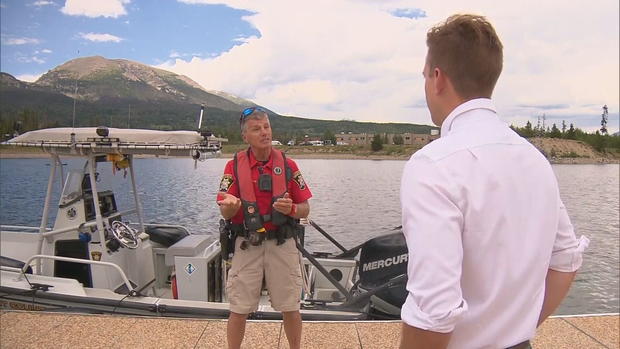Authorities plead with Coloradans to wear life jackets following deadly paddleboarding incident
Colorado Parks and Wildlife (CPW) believes 80% of drownings in Colorado this year could have been prevented by life jackets including the latest drowning death in Dillion Reservoir Saturday. CPW reports 26 people in Colorado have drown in our waters so far this year.
The Summit County Coroner's Office confirmed with CBS4 the 25-year-old paddleboarder found dead was Miguel Mendez from Englewood. Kevin Kelble, a Boat Ranger for Summit County Sheriff's Office was called in to help with the calls during the weekend's sudden and serious storm.
"We go from 0-5 knots of wind and great paddling conditions, and we can literally go to 50 MPH winds and 4-foot waves and that can all happen in 60 seconds or less in this lake. It's very sudden, dramatic, and it can be very terrifying," Kelble said.
The Summit County Sheriff's Office says a microburst storm is likely what threw Mendez from his paddleboard, and pushed it away from him while his lifejacket was strapped to the front of the board.
Mountain Newsroom reporter Spencer Wilson has covered the importance of wearing a lifejacket on the water, especially in this cold, mountain water ( Rangers told him Monday this is a perfect example of why they prefer people put the life jackets on, instead of riding with them on the board (although that is legal.)
"I can answer that with 100% certainty with a lifejacket on, he would have survived. It would have kept his head above water, he was only 75 yards offshore and he was being blown towards shore," Kelble said.
"With a life jacket he might have been panicked, he might have been terrified, but as long as his head was above water and he could breathe. Literally the wind would have blown him straight back to shore and we wouldn't be having this conversation right now," said Kelble.
Kelble said with how fast storms can pop up in the mountains, you never can know when you'll need your life vest, or if you will still be able to get to it. He compared it to a motorcyclist strapping their helmet to the back of their bike.
"You have the helmet, you are riding, but you lay the bike down at 70 miles per hour, you get this massive head injury where you could have prevented or helped prevent that head injury. It is the same thing with this tool that you can use that could save your life," Kelble said.





